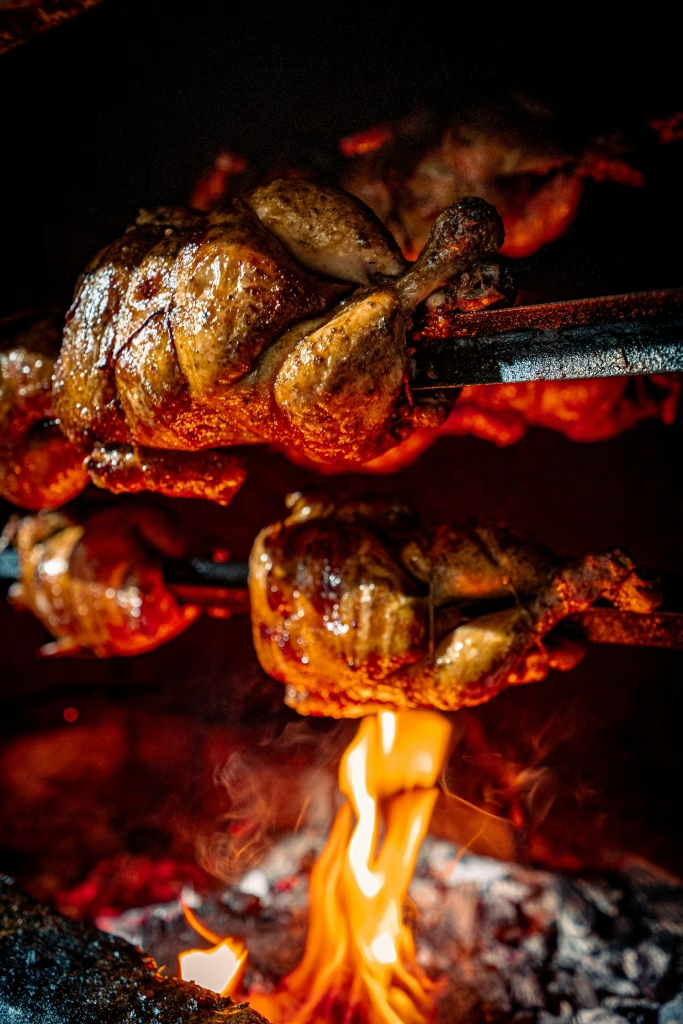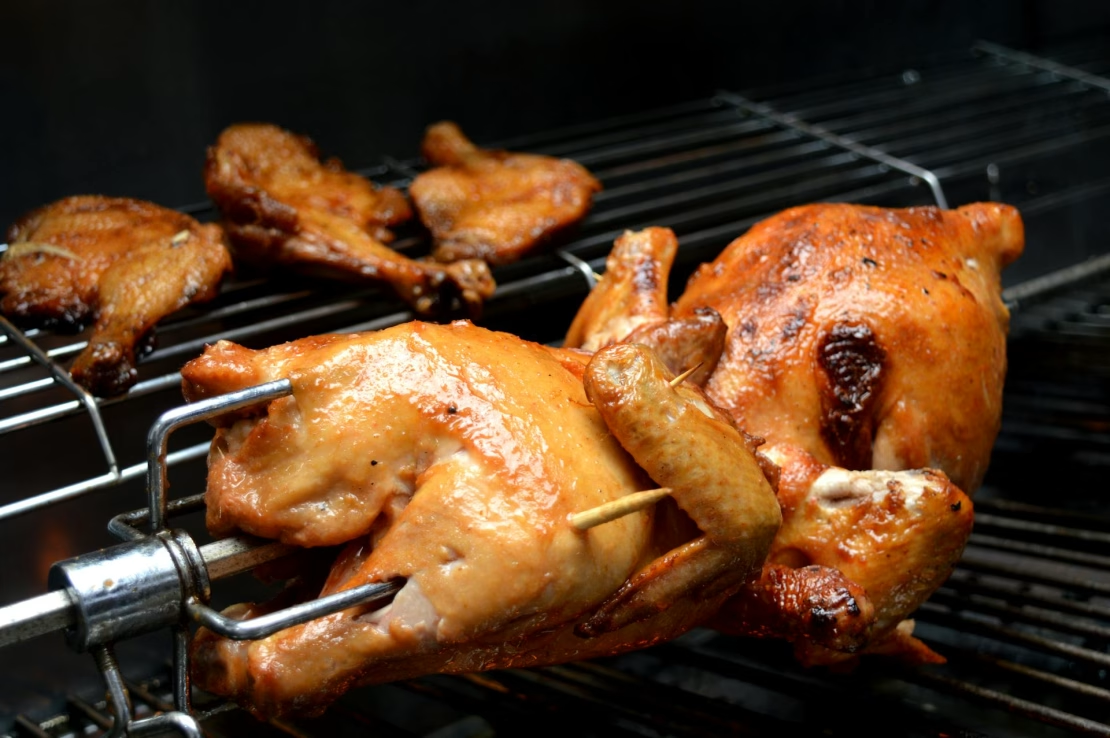Peruvian Pollo a la Brasa, also known as Peruvian rotisserie chicken, is a beloved staple in Peruvian cuisine and one of the most iconic dishes to emerge from South America.
With its crispy skin, juicy meat, and bold, smoky flavor, this dish is marinated in a rich blend of spices, herbs, and vinegar before being roasted to perfection—traditionally over charcoal. The marinade often includes garlic, cumin, paprika, soy sauce, and the signature aji peppers that give it a distinctive Peruvian character.
Usually served with crispy fries, fresh salad, and a creamy green sauce called aji verde, Pollo a la Brasa is a celebration of flavor, tradition, and culinary ingenuity.
Table of Contents
Ingredients
For the Chicken Marinade
- 1 whole chicken (about 3.5–4 lbs)
- 3 tablespoons soy sauce
- 2 tablespoons white vinegar (or red wine vinegar)
- 2 tablespoons lime juice
- 1 tablespoon olive oil
- 4 garlic cloves, minced
- 1 tablespoon ground cumin
- 1 tablespoon smoked paprika
- 1 tablespoon oregano
- 1 tablespoon sugar
- 1 teaspoon ground black pepper
- 1 teaspoon salt
- 1 teaspoon chili powder (or Peruvian aji panca paste, if available)
For Aji Verde Sauce
- 1 cup fresh cilantro (loosely packed)
- 2 jalapeños, seeded
- 2 garlic cloves
- 1/2 cup mayonnaise
- 1/4 cup sour cream or Greek yogurt
- 2 tablespoons lime juice
- 1 tablespoon white vinegar
- Salt to taste
Serves
Serves 4–6 people
Step-by-Step Instructions
1. Prepare the Chicken Marinade
- In a bowl, mix soy sauce, vinegar, lime juice, olive oil, minced garlic, cumin, paprika, oregano, sugar, pepper, salt, and chili powder or aji panca paste.
- Stir until well combined into a thick paste.
2. Marinate the Chicken
- Clean and pat dry the whole chicken. Optionally, spatchcock the chicken by removing the backbone so it lays flat.
- Rub the marinade all over the chicken, including under the skin and inside the cavity.
- Place in a large zip-top bag or covered bowl and refrigerate for at least 6 hours, preferably overnight.
3. Roast the Chicken
- Oven Method: Preheat oven to 425°F (220°C). Place chicken on a rack in a roasting pan. Roast for 45–55 minutes, or until internal temperature reaches 165°F (74°C) and skin is crispy.
- Grill/Rotisserie Method: Preheat charcoal grill or rotisserie setup. Roast over indirect heat, turning occasionally, for 1–1.5 hours.
4. Make Aji Verde Sauce
- Combine all ingredients in a blender or food processor. Blend until smooth. Adjust salt and lime to taste.
- Refrigerate until ready to serve.
5. Serve
- Rest the chicken for 10 minutes before carving.
- Serve with fries, salad, and a generous drizzle of aji verde sauce.
Serving Suggestions
- Traditional Side: Crispy French fries or roasted potatoes with a sprinkle of sea salt.
- Fresh Contrast: Simple salad of lettuce, tomato, red onion, and lime vinaigrette.
- Dipping Heaven: Always serve with aji verde or another Peruvian hot sauce.
- Street Style: Shred the chicken into wraps or sandwiches with onions and sauce.
- Family Style: Place carved chicken on a large platter for sharing.

Tips for Perfect Pollo a la Brasa
- Marinate Overnight: This ensures the chicken soaks up all the flavors.
- Use Aji Panca or Aji Amarillo: For authentic Peruvian flavor, source these specialty pastes.
- Spatchcock the Chicken: Helps cook more evenly and results in crispier skin.
- Charcoal Grilling: Adds a smoky depth similar to traditional rotisserie methods.
- Rest Before Carving: Let juices redistribute to keep the meat moist.
Healthier Alternatives
- Skinless Chicken: Remove the skin to reduce fat content, though it loses crispiness.
- Air Fryer Method: Cook spatchcocked chicken at 375°F (190°C) for 35–40 minutes.
- Yogurt Marinade Base: Use Greek yogurt instead of oil for a lighter marinade.
- Low-Fat Aji Verde: Use light mayonnaise or all Greek yogurt.
- Grilled Chicken Parts: Use breasts or thighs instead of a whole chicken for portion control.
Creative Variations
- Spicy Pollo a la Brasa: Add extra aji amarillo or red chili flakes for heat lovers.
- Citrus Twist: Add orange juice and zest to the marinade for brightness.
- Beer-Marinated Chicken: Use a dark lager or Peruvian Cusqueña for a rich flavor.
- Aji Verde Remix: Try avocado or fresh mint for a twist on the classic sauce.
- Mini Pollos: Use Cornish hens or chicken legs for a fun presentation.
Common Mistakes to Avoid
- Skipping the Marination Time: Less than 4–6 hours won’t infuse enough flavor.
- Not Patting the Chicken Dry: Excess moisture prevents crisp skin.
- Overcrowding the Pan: Airflow is key for even roasting.
- Overcooking: Use a meat thermometer to avoid dry chicken.
- Uneven Grilling Heat: Maintain indirect heat to prevent burning.
- Using Low Heat: High heat is crucial to get a crispy, browned exterior.
- Forgetting to Rest the Chicken: Cuts too early will release juices prematurely.
- Unbalanced Marinade: Taste and adjust acid, salt, and spice before applying.
- Neglecting the Sauce: Aji verde is a must—it elevates the whole dish.
- Ignoring the Sides: The fries and salad complete the authentic experience.
History of Peruvian Pollo a la Brasa
Pollo a la Brasa was born in Lima in the 1950s, when Swiss immigrant Roger Schuler and his associate Franz Ulrich began roasting chickens on a homemade rotisserie spit. They combined European techniques with local Peruvian ingredients and spices. Initially served at Schuler’s restaurant, “Granja Azul,” the dish became a hit due to its crispy exterior, juicy interior, and rich, complex flavor.
As its popularity spread, restaurants across Peru began adapting and reinventing the preparation. Many began serving it with traditional sauces and condiments like aji verde and fries, creating a new national tradition. It quickly evolved from a restaurant dish to a national obsession, available everywhere from fast-food chains to high-end eateries.
Today, Pollo a la Brasa is one of Peru’s most consumed dishes. It’s celebrated on National Pollo a la Brasa Day (the third Sunday in July) and has crossed borders into North America, Europe, and beyond. Its rise reflects Peru’s rich culinary fusion of Indigenous, European, African, and Asian influences—making it a true global ambassador of Peruvian flavor.
FAQs about Peruvian Pollo a la Brasa
1. What does “Pollo a la Brasa” mean?
It translates to “rotisserie chicken” or “chicken on the embers,” referring to its traditional cooking method over coals.
2. Can I make it without a rotisserie or grill?
Yes, oven-roasting at high heat works wonderfully and still delivers crispy skin.
3. What is aji panca?
Aji panca is a mild Peruvian red pepper with a smoky, slightly fruity flavor. It’s essential for authentic taste.
4. What’s the difference between aji panca and aji amarillo?
Aji panca is dark red and mild, while aji amarillo is yellow, fruity, and medium-hot.
5. How long should I marinate the chicken?
Ideally 12–24 hours, but a minimum of 6 hours is acceptable for decent flavor.
6. Is Pollo a la Brasa spicy?
Not necessarily, but it can be made spicy by adding more chili or using hot sauces.
7. What cut of chicken works best?
A whole chicken is traditional, but thighs and drumsticks work well too for quicker cooking.
8. What is the green sauce served with it?
It’s called aji verde, a Peruvian cilantro-jalapeño sauce that’s creamy and tangy.
9. Can I store leftovers?
Yes. Store in the fridge for up to 4 days. Reheat in the oven to maintain crispness.
10. What makes this dish uniquely Peruvian?
The use of native peppers, spice blends, and the pairing with traditional sauces like aji verde make it distinctly Peruvian.
Peruvian Pollo a la Brasa is more than just a roast chicken—it’s a celebration of Peru’s cultural richness and bold culinary spirit. With deep roots in both indigenous and European traditions, this dish captures the essence of Latin American flavor in every bite. Its crispy skin, savory marinated meat, and zesty aji verde sauce make it a truly irresistible experience. Whether grilled over charcoal or baked in a home oven, Pollo a la Brasa brings restaurant-quality flavor right to your kitchen. Perfect for a family dinner, summer cookout, or festive gathering, it’s a dish that unites everyone around the table. Give this recipe a try and discover why it’s one of Peru’s most cherished culinary treasures.


